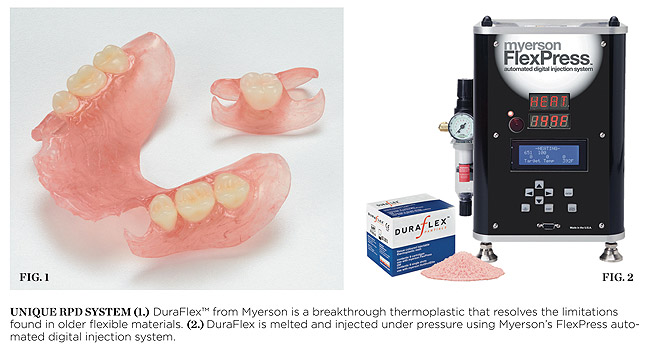DuraFlex™ Flexible Partials
Advanced material can improve patient acceptance and clinical results.
Two materials that are still commonly used in dentistry today, cobalt chrome alloy and nylon, were invented nearly 80 years ago. The use of cobalt chrome for removable partial denture (RPD) frameworks gained popularity in the 1930s after the price of gold had doubled. Nylon, the first commercially successful synthetic polymer, was invented in 1938 and used to make toothbrush bristles; 20 years later nylon began to be used as a flexible RPD material. RPD techniques and materials may have evolved very slowly over the ensuing decades, but recent advances in thermoplastic technology and dramatic changes in demographics are promising to reshape the place of removable prosthetics in clinical dentistry.
Demographic Changes
The niche occupied by RPDs in the dental practice is a function of oral health, professional care, and economics. While the percentage of the US population that is fully edentulous has declined over the past 20 years due to advances in oral health, the percentage of partially dentate patients has risen. This shift toward a greater percentage of partially dentate patients, when combined with the significant increase in the 65-and-older population that is expected over the next 20 years, could stimulate greater patient demand for RPDs.
Flexible RPDs
A recent survey1 indicates that 70% of dentists provide flexible partial dentures in their practice and that 25% to 30% of all RPDs prescribed are flexible. The widespread and growing acceptance of flexible partial dentures is primarily due to patient considerations: patients largely find them to be more comfortable, more esthetic and easier to insert than metal-based partials.
Besides those patients preferring enhanced comfort and esthetics, flexible partial dentures are also useful for patients who may have acrylic or metal allergies or who would simply prefer a metal-free removable. A clinical advantage of flexible partials is that they are minimally invasive: no tooth preparation or occlusal rest seats are required, which allows to them to be easily and successfully incorporated as interim prostheses in implant treatment planning.
Flexible partial dentures are contraindicated, however, when vertical clearance is limited to 3 mm or when abutment teeth have minimal undercuts. The most common complaints about flexible partials have been that they are difficult to adjust, they may stain or develop odors over time, and teeth cannot be added after the initial denture is fabricated.
Advantages of DuraFlex Flexible Partials
DuraFlex™ from Myerson (Figure 1) is a breakthrough thermoplastic that resolves the limitations found in older flexible materials like nylon, while still offering all the advantages of a flexible partial over a chrome RPD. DuraFlex is melted and injected under pressure using Myerson’s FlexPress automated digital injection system (Figure 2). The result is a flexible partial that for the dentist and dental technician is easier to adjust, easier to polish, and will not “gum up” rotary instruments like other flexible materials.
The advanced thermoplastic used to make DuraFlex has a semi-crystalline polymer structure, making it both strong and hygienic. It is clinically unbreakable and more durable than acrylic. Myerson’s internal research has shown that this state-of-the-art thermoplastic material is unusually resistant to water absorption, making it less prone than nylon to absorbing stains or odors.
DuraFlex also offers highly desirable esthetics, with a veined appearance in six gingival colors and one transparent color. The material is translucent, allowing the natural coloring of the underlying tissue to show through, giving it a virtually invisible appearance.
DuraFlex is available on a prescription basis only through authorized DuraFlex laboratories. Myerson can guarantee that its authorized laboratories have received extensive training in flexible partial denture design and processing, are equipped with Myerson’s FlexPress injection system, and use authentic DuraFlex material to fabricate flexible partials. Authorized DuraFlex laboratories are able to rebase, repair, and even add teeth to Duraflex flexible partials.
Flexible partial dentures offer the dental profession a more comfortable and esthetic alternative to conventional metal-based partials; they also serve a useful role in implant treatment planning. Expected shifts in demographics should only serve to increase the number of patients who could benefit from this treatment option.
Acknowledgment
DuraFlex flexible partial photo courtesy of Keller Laboratories.
Reference
1. Christensen GJ. Clinician’s Report. 2011;4(1).
for more information, contact:
Myerson
Phone: 800-423-2683
Web: www.myersontooth.com
Disclaimer
The preceding material was provided by the manufacturer. The statements and opinions contained therein are solely those of the manufacturer and not of the editors, publisher, or the Editorial Board of Inside Dentistry.






